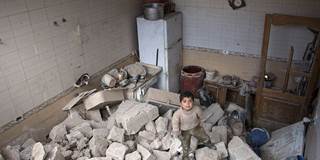Educational institutions, like health-care facilities, are supposed to be safe havens. But, as the attacks on schools in countries such as Sudan, Syria, Thailand, and Yemen show, they are often under direct threat in conflict zones.
DOHA, LONDON – In conflict zones, it is children who often bear the brunt of the violence. Last month, repeated air strikes on a school compound in Idlib, Syria, killed at least 22 children; and children in the besieged Syrian city of Aleppo have, for months, had no way to escape near-constant bombardments. As the New York Times reported in September, “They cannot play, sleep or attend school. Increasingly, they cannot eat.”
Just a few weeks before that report, a bomb was detonated outside a school in Southern Thailand, just as parents were dropping off their children. The blast instantly killed a father and his four-year-old daughter, and injured ten others. Brad Adams of Human Rights Watch described the bombing as an act of “incomprehensible brutality”: “Calling this a war crime does not fully convey the harm done to the victims, or the far-reaching impact such attacks have on children in the region.”
And just weeks before the Thailand bombing, on August 13, air strikes on a school in Yemen’s northwestern Saada region killed ten children and injured about 30 more.

DOHA, LONDON – In conflict zones, it is children who often bear the brunt of the violence. Last month, repeated air strikes on a school compound in Idlib, Syria, killed at least 22 children; and children in the besieged Syrian city of Aleppo have, for months, had no way to escape near-constant bombardments. As the New York Times reported in September, “They cannot play, sleep or attend school. Increasingly, they cannot eat.”
Just a few weeks before that report, a bomb was detonated outside a school in Southern Thailand, just as parents were dropping off their children. The blast instantly killed a father and his four-year-old daughter, and injured ten others. Brad Adams of Human Rights Watch described the bombing as an act of “incomprehensible brutality”: “Calling this a war crime does not fully convey the harm done to the victims, or the far-reaching impact such attacks have on children in the region.”
And just weeks before the Thailand bombing, on August 13, air strikes on a school in Yemen’s northwestern Saada region killed ten children and injured about 30 more.